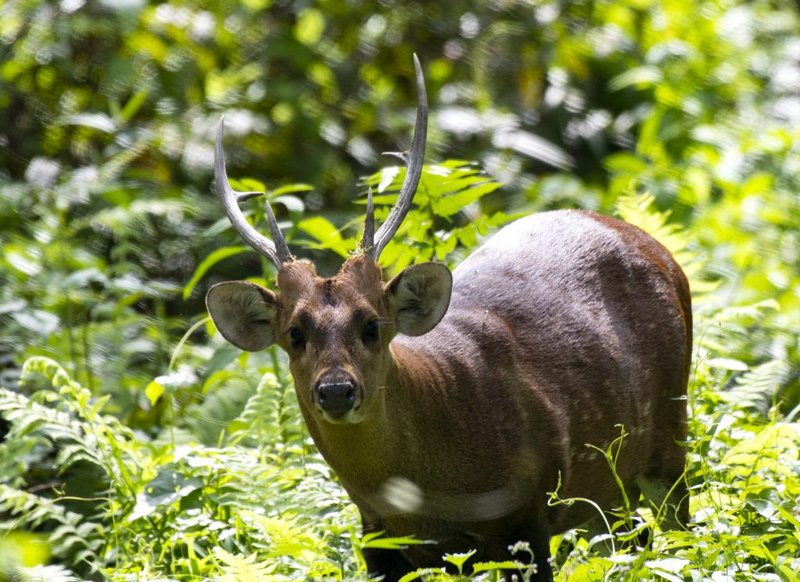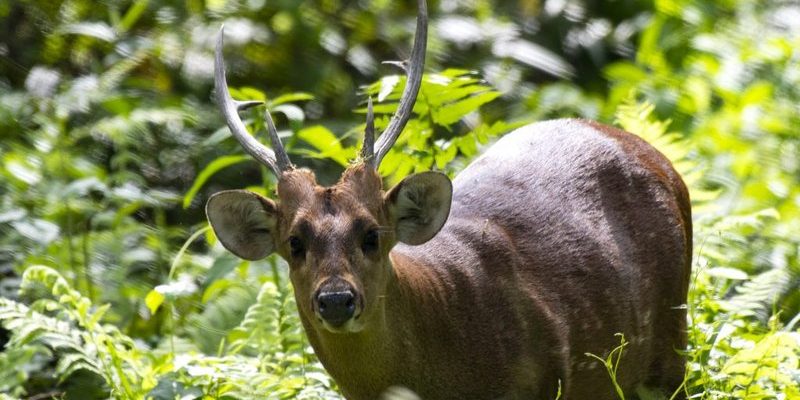
The Hog Deer is a fascinating creature that many people may not know much about. Imagine a sleek, graceful animal that roams through wetlands and grasslands, much like a gentle ghost moving through a misty landscape. These deer, native to South Asia, blend effortlessly into their surroundings and play an important role in their ecosystems. Understanding Hog Deer can give us insight into the delicate balance of nature and the importance of preserving their habitats.
Often overshadowed by more well-known deer species, Hog Deer are unique in their behaviors and habitats. Unlike their cousins, who prefer forested environments, these deer thrive in open spaces where they can easily graze on grasses and other vegetation. If you’ve ever wondered about the quirks of wildlife, diving into the world of Hog Deer is a delightful adventure. So, let’s explore these enchanting creatures together!
Physical Characteristics of Hog Deer
Hog Deer are distinctively shaped and sized, contributing to their charm. An adult Hog Deer typically weighs between 50 to 90 pounds, with males being larger and heavier than females. What’s truly striking is their body structure; they are more robust and stocky compared to other deer. This shape helps them navigate through their grassy habitats with ease.
When you look closely, Hog Deers have a beautiful coat that ranges from reddish-brown to a more muted gray-brown. This coloration helps them blend into their environment, providing camouflage from predators. Their legs are relatively short, giving them a unique “hog-like” appearance, which is how they got their name. Their most notable feature, however, might be the males’ antlers, which are usually three-tined and can grow up to 30 inches in length. Quite impressive for such an elegant creature!
Habitat and Distribution
Hog Deer primarily inhabit marshes, swamps, and the edges of tall grasslands. They prefer wet environments where they can find plenty of food. This makes countries like India, Nepal, and Sri Lanka their natural homes. Within these regions, they often seek out areas that flood seasonally, which provide rich grazing opportunities.
You might be wondering why these deer favor wet habitats. The answer lies in their diet. Being herbivores, they primarily feed on grasses, reeds, and tender shoots found in these marshy areas. The presence of water not only supports their food sources but also provides a place for them to hide from predators like tigers and leopards. Their ability to adapt to their surroundings showcases their survival skills and ecological importance.
Dietary Habits of Hog Deer
Hog Deer are primarily grazers, and their diet consists mainly of grasses and aquatic plants. This is quite fortunate for them, as their wetland habitats provide a steady supply of these food sources. They also enjoy browsing on shrubs and young trees, especially during times when grass is less available.
In the early morning and late afternoon, you can often spot these deer munching peacefully on their favorite snacks. They have a unique way of feeding that involves cropping the grass and often leaving the area looking like a well-manicured lawn. This behavior is important not only for their health but also for maintaining the ecosystem. By eating certain plants, they help control plant growth, which in turn supports a diversity of other wildlife.
Reproductive Behavior and Lifecycle
The breeding season for Hog Deer typically occurs during the monsoon months, which are crucial for their reproduction. Males become quite territorial and will often display their strength through vocalizations and showcasing their antlers to attract females. This is where nature can get a little dramatic—imagine a ballet of strength and elegance as males compete for the attention of the females!
After a gestation period of about seven months, females usually give birth to a single fawn. This young deer is born with spots that aid in camouflage, protecting it from potential predators. The mother is very nurturing, providing care and guidance to her fawn, which learns to graze and hide as it grows. By approximately six months, the young deer is weaned and begins to explore the world on its own, blending into the environment in remarkable ways.
Conservation Status and Threats
Unfortunately, the Hog Deer faces several threats that endanger its population. Habitat loss due to agricultural expansion, urban development, and poaching have led to a significant decline in their numbers. Conservation efforts are underway in various regions, focusing on habitat restoration and protection strategies to ensure the survival of these gentle grazers.
Moreover, Hog Deer are particularly vulnerable to changes in their environment, primarily due to shifting weather patterns and human encroachment. Governments and wildlife organizations are working together to create protected areas and resolve conflicts between wildlife and farming. It’s vital that we advocate for these efforts and encourage sustainable practices that benefit both humans and wildlife.
Interesting Facts About Hog Deer
| Scientific Name: | Axis porcinus |
| Size: | 50–90 pounds (22–40 kg) |
| Lifespan: | 10–15 years in the wild |
| Habitat: | Wetlands, swamps, grasslands |
| Diet: | Grasses, reeds, tender shoots |
| Color: | Reddish-brown to gray-brown |
| Distribution: | India, Nepal, Sri Lanka |
Behavioral Traits
Hog Deer are known for their unique behaviors that not only reflect their adaptability but also their social structures. These deer tend to be more active during dawn and dusk, which is when they feel safest foraging. This crepuscular pattern helps them avoid the heat of daytime and the watchful eyes of predators. Watching them graze in the twilight can be a mesmerizing experience, as they move quietly among the grasslands, perfectly at ease.
In terms of social behavior, Hog Deer are often found in small groups, typically consisting of females and their young. Males usually lead a more solitary lifestyle, coming together with females only during the breeding season. This structure helps minimize competition for food and maintains social harmony. It’s fascinating how their social interactions mirror the dynamics often seen in larger deer species, despite their smaller size and different habitat preferences.
Hog Deer in Popular Culture
Interestingly, the Hog Deer has also made its way into various facets of popular culture, especially in regions where they reside. Local folklore often paints them as gentle spirits of the wetlands, embodying grace and tranquility. They are sometimes featured in stories and art, symbolizing harmony with nature and the delicate balance of ecosystems.
Moreover, the conservation of Hog Deer and their habitats often becomes a rallying point for environmentalists, promoting awareness about the importance of preserving not just the deer but the entire ecosystem they inhabit. Through educational programs and community engagement, people are encouraged to appreciate the beauty of these animals and take action to protect their homes. This cultural significance underscores the undeniable connection between wildlife and humanity, calling for a collective effort to foster coexistence.
Understanding the Hog Deer gives us a glimpse into the intricate web of life within our ecosystems. These gentle grazers, with their unique adaptations and behaviors, remind us of the beauty that exists in nature and the responsibilities we have to protect it. The more we learn about them, the more we can contribute to their conservation and ensure future generations can enjoy the wonders of the natural world.
FAQ
What is the main habitat of Hog Deer?
The Hog Deer primarily inhabits wetlands, swamps, and grasslands. These environments provide them with the necessary food and cover from predators. They tend to prefer regions that experience seasonal flooding, as this creates rich grazing opportunities that are crucial for their diet.
Are Hog Deer endangered?
Hog Deer are currently classified as vulnerable due to habitat loss and poaching. Conservation efforts are in place to protect their habitats and reduce human-wildlife conflicts. Awareness and engagement are vital to ensuring that these gentle creatures have a future.
How do Hog Deer communicate?
Hog Deer communicate through a variety of vocalizations, as well as through body language. Males may grunt or grunt-like sounds during breeding season to assert dominance and attract females. Social interactions among groups also involve subtle movements and positioning to convey information about safety and feeding opportunities.
What do Hog Deer eat?
Hog Deer are herbivores that primarily feed on grasses, reeds, and soft shoots found in their wetland habitats. Their diet is crucial for maintaining both their health and the ecology of their environment. By feeding on certain plants, they help control plant growth and promote biodiversity.
How fast can Hog Deer run?
Hog Deer are quite agile; they can reach speeds of up to 30 miles per hour (48 kilometers per hour) when necessary. This speed helps them escape from predators and navigate through their marshy habitats swiftly. Their short legs and stocky build give them stability, which aids in quick movements across uneven terrain.
What are the breeding habits of Hog Deer?
Hog Deer typically breed during the monsoon season, leading to higher chances of survival for their young due to the abundant food supply. Males are known to establish territories and compete for females during this time. After a gestation period of about seven months, females usually give birth to a single fawn.
How long do Hog Deer live?
In the wild, Hog Deer typically have a lifespan of about 10 to 15 years. Factors like habitat quality, availability of food, and predation significantly influence their longevity. In protected environments, they may live even longer, benefiting from reduced threats.

